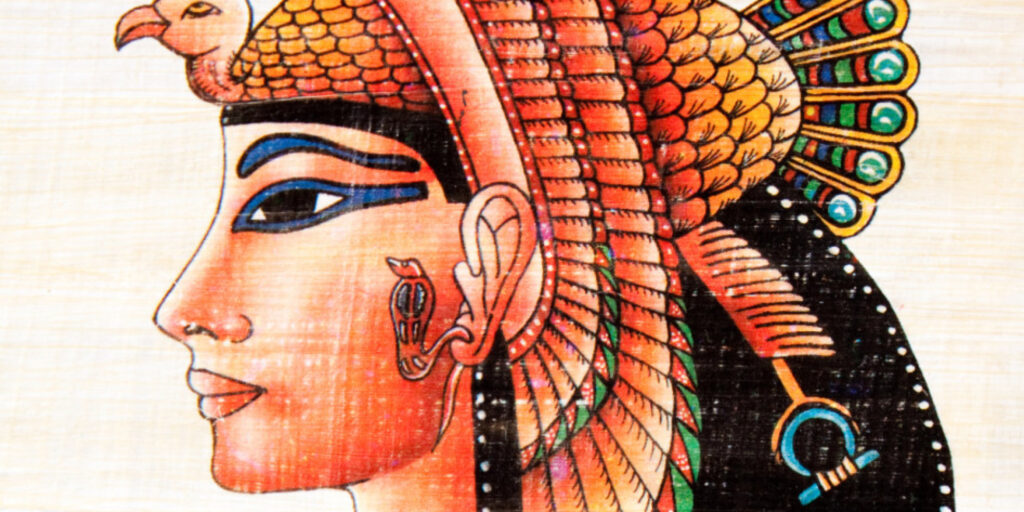 On this year’s International Women’s Day today, Egypt Travel Blog would like to pay homage to one of ancient Egypt’s most famous figures and a woman whose life and legacy are worthy of remembrance.
On this year’s International Women’s Day today, Egypt Travel Blog would like to pay homage to one of ancient Egypt’s most famous figures and a woman whose life and legacy are worthy of remembrance.
Cleopatra is one of the most famous women in all of human history. She was a beloved queen of an ancient people who skillfully forged powerful alliances through love, lust, and marriage and waged war for the preservation of her empire. In the end, though, she and her mighty empire were ultimately defeated by the even mightier Rome, and Cleopatra is said to have committed suicide on 12 August 30 B.C. rather than witness the end of an independent Egypt.
With Cleopatra’s tragic demise also came the virtual disappearance of all physical traces of her existence from the earth, as the location of her burial site and remains have been lost to antiquity. But in a sense, a part of history’s greatest queen did survive for an unknown period of time – her DNA – via at least one known surviving child whose decedents criss-crossed the Mediterranean for centuries in royal marriage after royal marriage.
Cleopatra herself bore at least four children. The first of which we know was fathered by Julius Caesar, and the next three by fellow Roman Mark Antony. After Cleopatra’s death, her eldest son and successor, Caesarion, was assassinated on the order of Octavian, later the Roman Emperor Augustus. Her three remaining children were taken to Rome, but her two surviving male children soon mysteriously disappeared from history. This leaves only a daughter named Cleopatra Selene as her only surviving offspring.
After being paraded through the streets of Rome in gold chains with her brothers so that Rome could revel in its victory over Egypt, Cleopatra Selene, also known as Cleopatra VIII (her famous mother was not actually the first Cleopatra, but the seventh, although by far the greatest), was raised and educated in the royal Roman household before being strategically married off to King Juba II of the north African kingdom of Numidia (present-day Libya and Algeria, but then a Roman client-state). The couple were later sent westward to rule over another Roman client-state called Mauretania, which is now present-day Morocco.
With Juba II, Cleopatra Selene had a son that she named Ptolemy in honor of the last dynasty of pharaohs that ended with her late mother and brother. Ptolemy of Mauretania became king in 23 A.D. on the death of his father and in 38 A.D. his wife gave birth to a daughter named Drusilla. Two years later, King Ptolemy was called to Rome by the Emperor Caligula where he was assassinated on the ordered of the Emperor.
After she came of age, Drusilla was married off to the Roman governor of Judea, Marcus Antonius Felix, although we do not know of them producing any children. After he divorced her and married another local princess named Drusilla, Drusilla of Mauretania married again, this time to King Sohaemus of Emesa, another Roman client-state in modern-day Syria. With Sohaemus Drusilla bore a son named Gaius Julius Alexio, who became known as Alexio II upon becoming king in 73 A.D.
Alexio’s reign was short, however, and he died just five years later in 78 A.D., but not before producing a son and heir named Gaius Julius Fabia Sampsiceramus Silas, or Silas III after he became King of Emesa. King Silas continued to pass along Cleopatra’s bloodline to his offspring, including his heir Gaius Julius Longinus Soaemus, later King Soaemus.
At least one more generation of Cleopatra’s legitimate direct decedents is known to have ruled in Emesa, namely Gaius Julius Sulpicius, son of Soaemus. After that the historical record begins to get a bit murky. Some believe the line continued for several more generations until it circled back to join the Roman imperial line with the daughter of Emesean king Gaius Julius Bassianus, Julia Domna, who married Roman Emperor Lucius Septimius Severus and bore him two sons who would become the emperors Geta and Caracalla.
Aside from “legitimate” royal descendants, it is highly likely that Cleopatra’s male descendants also had numerous extra-marital offspring who co-mingled with the noble and common populations across the ancient Mediterranean world. But knowledge of these common descendants and her royal offspring alike have since been lost to history. Regardless of an absence of her physical and genetic legacy, the historical record of Cleopatra’s greatness lives on and her incredible legacy remains larger than life.




